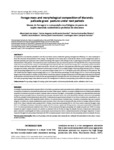Please use this identifier to cite or link to this item:
http://www.alice.cnptia.embrapa.br/alice/handle/doc/1053037Full metadata record
| DC Field | Value | Language |
|---|---|---|
| dc.contributor.author | ANJOS, A. J. DOS | pt_BR |
| dc.contributor.author | GOMIDE, C. A. de M. | pt_BR |
| dc.contributor.author | RIBEIRO, K. G. | pt_BR |
| dc.contributor.author | MADEIRO, A. S. | pt_BR |
| dc.contributor.author | MORENZ, M. J. F. | pt_BR |
| dc.contributor.author | PACIULLO, D. S. C. | pt_BR |
| dc.date.accessioned | 2016-09-19T11:11:11Z | pt_BR |
| dc.date.available | 2016-09-19T11:11:11Z | pt_BR |
| dc.date.created | 2016-09-19 | pt_BR |
| dc.date.issued | 2016 | pt_BR |
| dc.identifier.citation | Ciência e Agrotecnologia, v. 40, n. 1, p. 76-86, 2016. | pt_BR |
| dc.identifier.uri | http://www.alice.cnptia.embrapa.br/alice/handle/doc/1053037 | pt_BR |
| dc.description | An evaluation of productive potential is not the only factor used to determine grazing management efficiency; it is also necessary to know the structural characteristics of the canopy. The objective of this study was to evaluate the effects of two management styles on Marandu palisade grass pastures under rotational stocking with respect to the herbage mass, morphological composition, and structural characteristics of the pasture. The treatments under consideration were a) a fixed rest period of 30 days (RP30) or b) a rest period based on the time necessary for the canopy to reach 95% light interception (LI95). The experimental design was a completely randomized block with two blocks and three replicates within the blocks. Animals were placed in the paddocks when the grass reached the established management criteria, which were maintained for three days to reach 25 cm in stubble height. Shorter grazing intervals (22.8 vs. 30 days), lower pre-grazing heights (35.9 vs. 42.3 cm), and lower forage masses (4,411 vs. 5,290 kg/ha.cycle) were observed in LI95 pastures. The LI95 treatment had a higher leaf percentage (48.3 vs. 41.1) and the lowest percentage of dead forage (19.0 vs. 25.4) in the pre-grazing forage mass of the pasture in relation to that of RP30. Performing pasture management based on RP30 throughout the season is harmful to the pasture structure because it reduces the leaf percentage and increases the stem and senescent material in the available forage. The lower pre-grazing forage mass observed under LI95 management is offset by more grazing cycles within the rainy season. | eng |
| dc.language.iso | eng | eng |
| dc.rights | openAccess | eng |
| dc.subject | Pre-grazing height | pt_BR |
| dc.subject | Grazing cycle | pt_BR |
| dc.subject | Interception of photosynthetically active radiation | pt_BR |
| dc.subject | Leaf mass | pt_BR |
| dc.title | Forage mass and morphological composition of Marandu palisade grass pasture under rest periods. | pt_BR |
| dc.type | Artigo de periódico | pt_BR |
| dc.date.updated | 2017-02-23T11:11:11Z | pt_BR |
| riaa.ainfo.id | 1053037 | pt_BR |
| riaa.ainfo.lastupdate | 2017-02-23 | pt_BR |
| dc.identifier.doi | http://dx.doi.org/10.1590/S1413-70542016000100007 | eng |
| dc.contributor.institution | Albert José dos Anjos, Universidade Federal dos Vales do Jequitinhonha e Mucuri/UFVJM; CARLOS AUGUSTO DE MIRANDA GOMIDE, CNPGL; Karina Guimarães Ribeiro, UFV; Afrânio Silva Madeiro, UFRR; MIRTON JOSE FROTA MORENZ, CNPGL; DOMINGOS SAVIO CAMPOS PACIULLO, CNPGL. | pt_BR |
| Appears in Collections: | Artigo em periódico indexado (CNPGL)  | |
Files in This Item:
| File | Description | Size | Format | |
|---|---|---|---|---|
| Cnpgl2016CiAgrotecForage.pdf | 704,69 kB | Adobe PDF |  View/Open |









